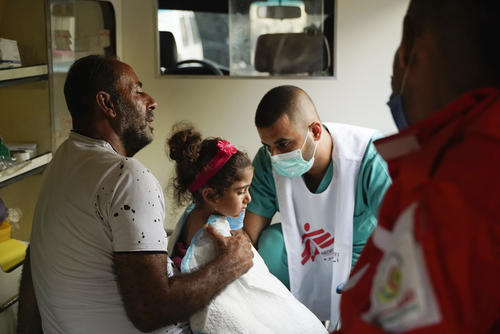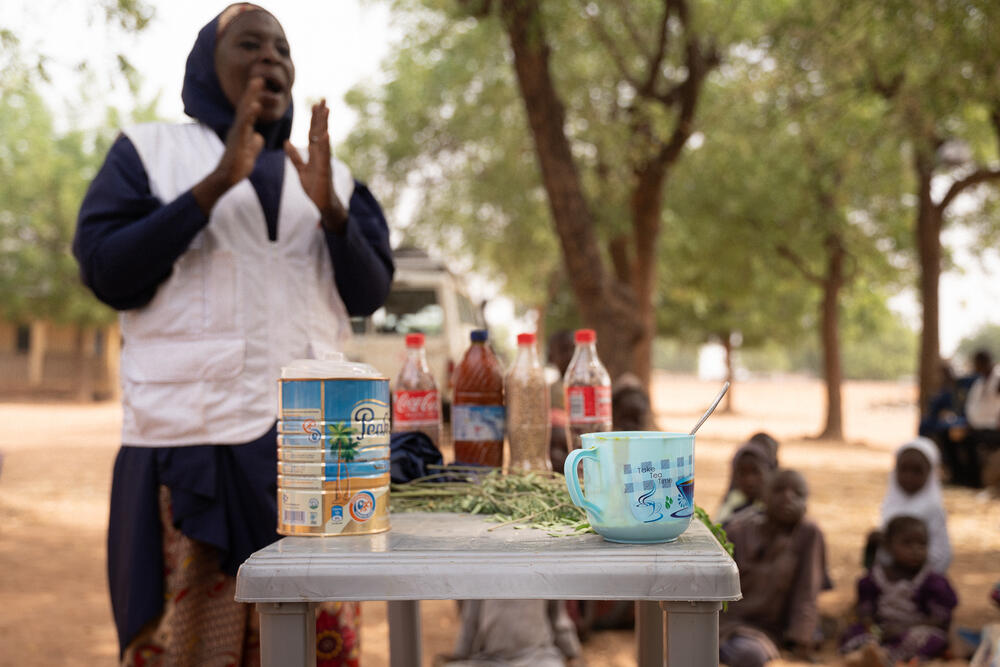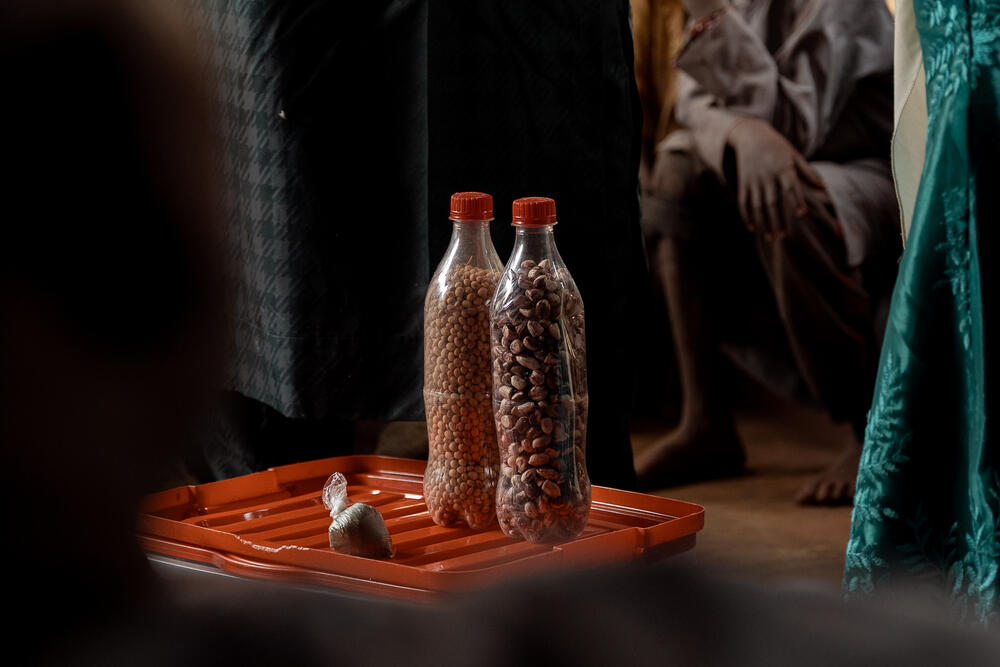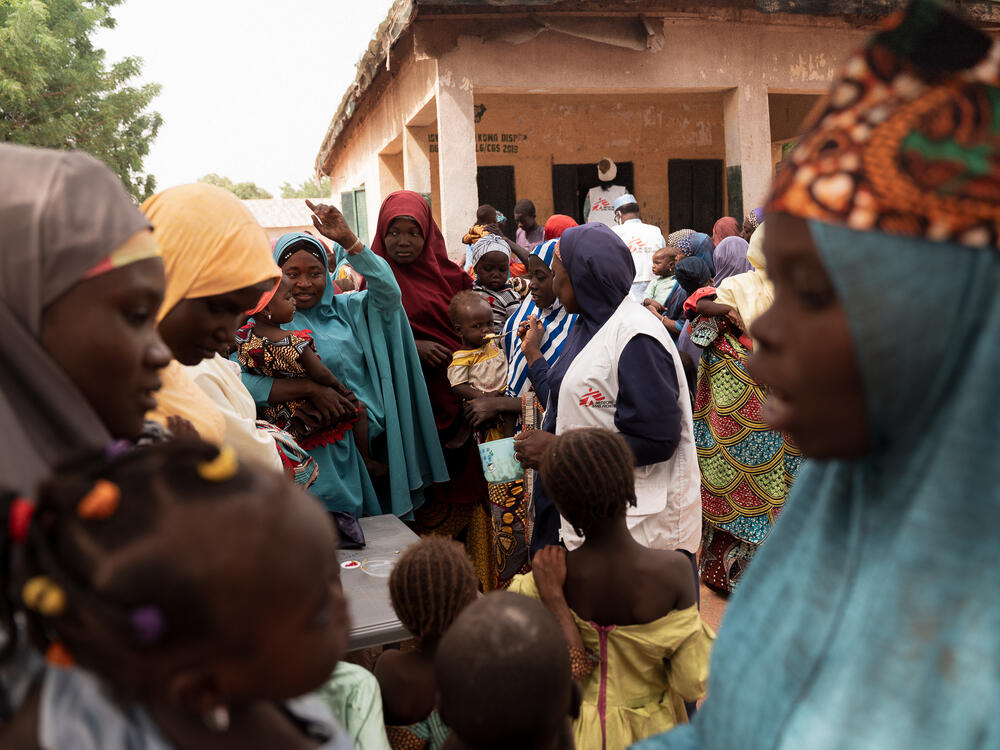How cooking classes help reduce child malnutrition in northern Nigeria
Like all other states in the northern part of Nigeria, Kebbi has experienced a colossal spike in malnutrition cases this year. Maryam Muhammad, head of the MSF health promotion team in Kebbi, believes the crisis calls for strong prevention efforts.
Médecins Sans Frontières / Doctors Without Borders (MSF) teams try to provide life-saving medical care while also supporting community-led activity. One example is the ‘Tom Brown’ recipe.
A local solution against malnutrition
Four days a week, Maryam and her team hit the long roads of Kebbi, travelling from community to community, their car packed with tables, saucepans, pots, spoons, and recycled soda bottles filled to the brim with soya beans, sorghum, moringa leaves, palm oil and groundnuts.
“That’s all we need to make ‘Tom Brown’ demonstrations,” she says while on the way to Maishaika, a village located 40 kilometres from MSF’s inpatient feeding centre. “This, and some catchy songs to make sure the recipe remains in everyone’s head.”
Stemming from a traditional Nigerian recipe known as ‘Kwash pap’, Tom Brown is a flour blend consumed as a sweetened porridge. The meal is made with nutritious ingredients that are cultivated in northern Nigeria and available in local markets. The recipe has been modified over the years by nutritionists to become a useful and very efficient tool in the prevention and treatment of moderate malnutrition.
Studies in 2022 and 2023 showed positive results, with Tom Brown potentially able to reach more children for the same cost as ready-to-use therapeutic food such as peanut paste.
Demonstrating the recipe
After a 35-minute ride, the jeep pulls into Maishaika. Maryam and her teammates make their way to the village elder to greet him and confirm his approval for today’s demonstration.
A few minutes later, the crew sets into motion. Tables, chairs and ingredients are unpacked and installed. Volunteers go from home to home to call on villagers. In a flash, the small village square transforms itself into a market stall and a hundred women rapidly gather on chairs and on the ground to see what’s happening.
Maryam, active as a health promoter for more than 15 years, knows how to catch and keep their attention. Full of energy, with a booming voice and a spoon in her hand, she starts explaining what acute malnutrition is and what they, mothers and grandmothers, can do to fight it.
Medical care where it's needed most
Help us care for people caught in the world's worst healthcare crises.

How to make Tom Brown
Putting words into action she calls on a woman from the audience to start preparing with her what will help keep acute malnutrition at bay: Tom Brown.
In Kebbi, the recipe is based on a simple ratio:
6 measures of sorghum or millet
3 measures of soybeans
1 measure of ground nuts
After a precise process of soaking, cleaning, drying and roasting, the ingredients are mixed for finer grounding into a powder. The powder is then mixed with clean water, poured into boiling water, and the resultant porridge is cooked over a fire for a few minutes.
Based on market availability, preferences and what the family can afford, additional elements such as palm oil, moringa leaves, cow milk or meat can be added to provide extra energy and nutrients to the child.
But with families facing rampant inflation and a continuous increase in the price of food items over the past months, adding additional ingredients look like a luxury that many cannot afford in Kebbi.
Training mothers and fathers
The way to prepare the recipe is sung on repeat, and cups are handed over to children to taste-test the pap. Women are laughing and smiling. A few metres away, the village elder looks upon the event with curiosity. He is the only man from the village watching the demonstration.
“The men will have a dedicated session on another day. For cultural reasons, we must separate the sessions,” says Maryam.
“But having them on board is key as they are the ones who supply the family [with food].
“In the beginning, some were worried about the kind of message that would be spread during the sessions with the women and told their wives not to come. So, we decided to have dedicated father-led sessions to show what we do and what we say. This helped a lot and now, men are showing real interest in such sessions.”
“We know that the people we train today will pass the recipe to others”
Recipes for life
After an hour of demonstration with the women, Maryam and her team pack their items up and call on all the mothers to stay to have their children screened for acute malnutrition through a rapid check using the mid-upper arm circumference measuring tape known as a MUAC bracelet. Among the 28 children screened on that day, more than a third of them are referred to MSF’s therapeutic nutrition programme.
“This kind of cooking demonstration is crucial because people understand that they can prevent their children from becoming acutely malnourished rather than bringing them to a facility to treat them”, Maryam says before jumping into the jeep. “Sustainable approaches are needed to reduce severe malnutrition. And we know that the people we train today will pass the recipe to others.”
Between January and May 2024, Maryam and the health promotion team organised 554 demonstrations around Kebbi. More than 13,300 people attended these events, including 1,461 men.
MSF and malnutrition
Around 45 percent of all deaths in young children are linked to malnutrition; when children suffer from acute malnutrition, their immune systems are so impaired that the risk of death is greatly increased.
In 2022, we admitted 127,400 severely malnourished children into inpatient feeding programmes (an increase of 55% on 2021) across the world, and 324,591 to outpatient programmes (an increase of 100% on 2021).


